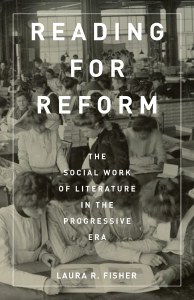JSTOR Daily: Philanthropy and the Gilded Age
 [Laura R.] Fisher’s Reading for Reform delves into the societal function that the clubs served and how they’re represented in literature of the era. Though working girls were expected to pay subscription fees to clubs to build “self-reliance,” they were also funded by wealthy women and staffed by middle class women. As she shows, working girls clubs were established to keep a burgeoning class of women new to the city and new to the workforce from spending their wages in bars and other sites of supposed disrepute. She argues that “the [working girls’ club] movement sought to create a new social taxonomy of white working women at a transitional moment in U.S. modernity.” Crucially, they encouraged working class women to make wealthy and middle class women objects of aspiration. As thinking behind the design of working girls’ clubs went, if working class women were in proximity with middle and upper class women and enculturated to share in their cultural pursuits, they would come to emulate their manners and lend respectability to working women. As Fisher points out, tensions in the club arose because of their conservative positions on labor issues. Rather than using the collective space of the working girls’ club to organize around poor working conditions and low wages, club leadership encouraged “self-discipline, obedience, and respect for employers.”
[Laura R.] Fisher’s Reading for Reform delves into the societal function that the clubs served and how they’re represented in literature of the era. Though working girls were expected to pay subscription fees to clubs to build “self-reliance,” they were also funded by wealthy women and staffed by middle class women. As she shows, working girls clubs were established to keep a burgeoning class of women new to the city and new to the workforce from spending their wages in bars and other sites of supposed disrepute. She argues that “the [working girls’ club] movement sought to create a new social taxonomy of white working women at a transitional moment in U.S. modernity.” Crucially, they encouraged working class women to make wealthy and middle class women objects of aspiration. As thinking behind the design of working girls’ clubs went, if working class women were in proximity with middle and upper class women and enculturated to share in their cultural pursuits, they would come to emulate their manners and lend respectability to working women. As Fisher points out, tensions in the club arose because of their conservative positions on labor issues. Rather than using the collective space of the working girls’ club to organize around poor working conditions and low wages, club leadership encouraged “self-discipline, obedience, and respect for employers.”
Read the article at JSTOR Daily.



